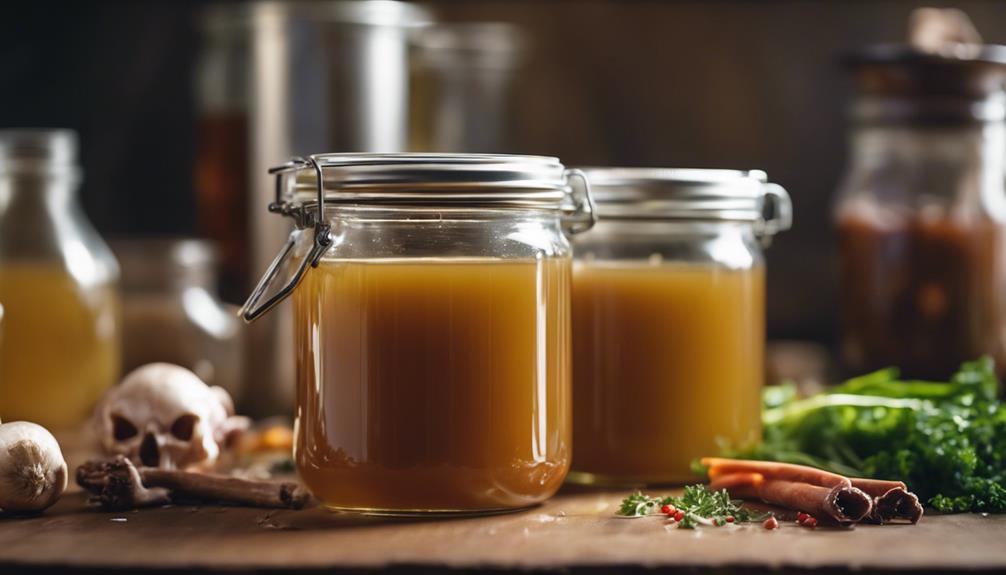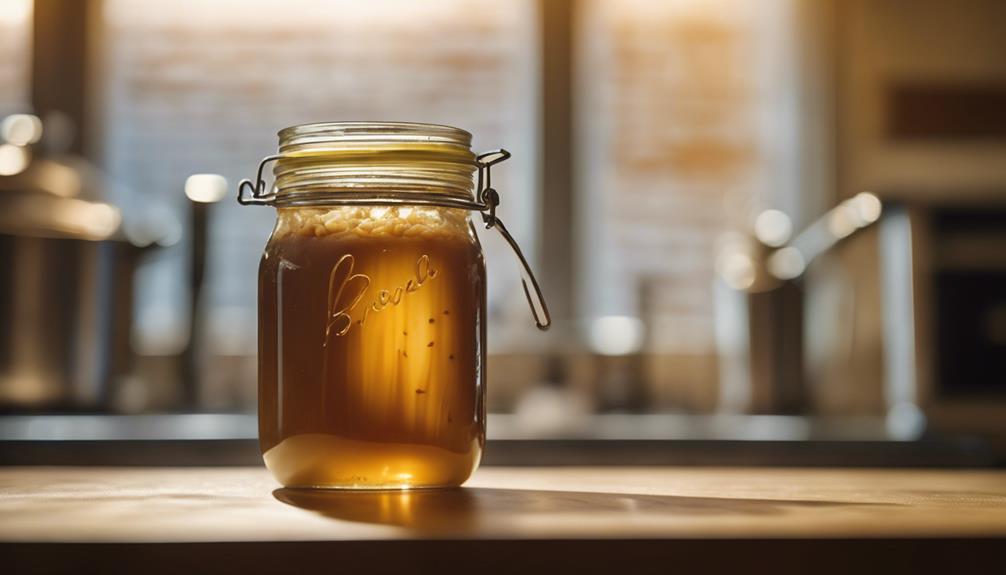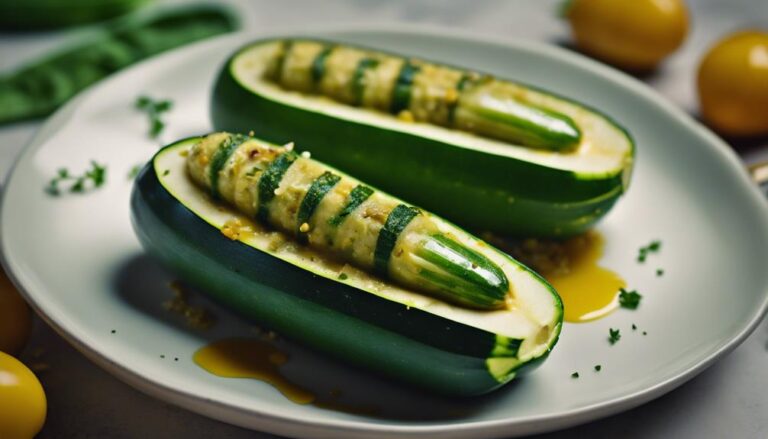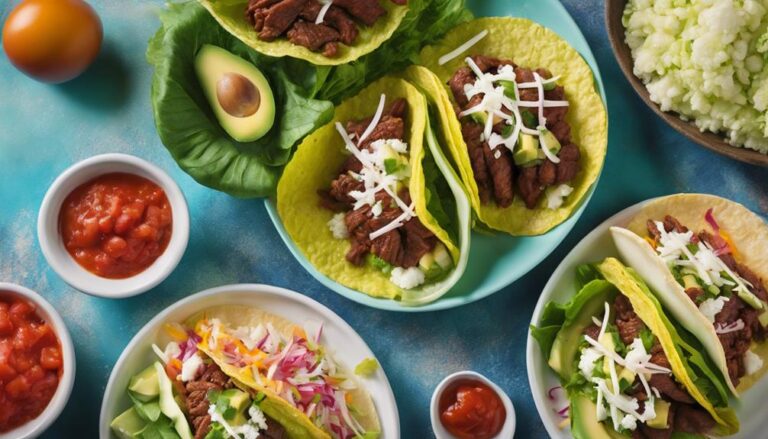Sous Vide Beef Bone Broth
To make sous vide beef bone broth, seal beef bones in a bag, vacuum out air, then cook in a water bath at a precise temperature for hours. This method guarantees maximum nutrient extraction and flavor infusion, resulting in a rich, collagen-packed broth. The sous vide technique preserves more nutrients, delivering a consistently flavorful stock without the risk of overcooking. Tantalize your taste buds with this nutrient-dense, exceptional broth.
What You Will Learn Here
- Sous vide method optimizes collagen extraction for rich, gelatinous beef bone broth.
- Precise temperature control enhances nutrient retention in sous vide beef broth.
- Anova Sous Vide machine ensures consistent, flavorful bone broth without overcooking.
- Slow cooking process in sous vide preserves natural flavors and nutrients effectively.
- Sous vide beef bone broth offers convenient, nutrient-dense, and exceptional results.
Bone Broth Origins

Bone broth has a rich history rooted in diverse cultures, with traditional recipes emphasizing the extraction of nutrients from bones, vegetables, and herbs over prolonged periods.
Ancient civilizations recognized bone broth for its potential health benefits, particularly in maintaining gut health, joint function, and overall wellness.
The origins of bone broth are deeply intertwined with cultural practices that prioritize holistic well-being through the consumption of nutrient-rich broths.
Bone Broth History
Dating back to ancient times, the practice of making bone broth has been a longstanding tradition rooted in its nutritional and medicinal properties. Utilizing beef bones, this ancient elixir was highly valued in traditional diets for its ability to extract essential nutrients and minerals from the bones and connective tissues.
Across various cultures, bone broth was a revered healing food, with traditional Chinese medicine highlighting its role in supporting kidney health and nourishing the blood. As time progressed, the popularity of bone broth continued to rise, driven by its nutrient-rich composition and potential health benefits.
This historical journey showcases the enduring significance of bone broth as a nourishing and therapeutic staple in culinary traditions worldwide.
Traditional Bone Broth
Simmering bones in water for an extended period results in the extraction of minerals, collagen, and amino acids, creating traditional bone broth with a gelatinous texture. This slow cooking process effectively breaks down the collagen within the bones, releasing beneficial nutrients.
Traditional bone broth, such as beef bone broth, has been a staple in various cultures for centuries, valued for its health benefits and nutrient-rich composition. The collagen and amino acids present in bone broth are believed to support gut health, joint function, and overall well-being.
Different cultures have their own unique variations of traditional bone broth recipes, often adding herbs, spices, and vegetables to enhance flavors and maximize health benefits. Incorporating bone broth into your diet can be a nourishing way to support your health and wellness.
Cultural Bone Broth
Having explored the traditional method of creating bone broth through simmering bones for an extended period, it's now important to examine the cultural origins of this nourishing elixir found in various culinary practices worldwide.
Beef stock, a common form of bone broth, has been integral in Western cuisine for centuries, used as a base for soups, stews, and sauces. In contrast, chicken bone broth is prevalent in Asian cultures, where it's often infused with herbs and spices for added health benefits. Different regions have unique variations of bone broth, reflecting local ingredients and culinary traditions.
The origins of bone broth can be traced back to ancient civilizations, where utilizing every part of the animal for sustenance and health was paramount.
Key Broth Components

Key components of a well-crafted sous vide beef bone broth include rich collagen, essential minerals, and robust flavors extracted through precise cooking techniques. When making sous vide beef bone broth, it's essential to focus on these key elements:
- Beef Bones: The foundation of the broth, beef bones provide the essential nutrients, collagen, and flavor profile necessary for a hearty and nutritious broth.
- Collagen Extraction: Cooking the beef bones sous vide at a precise temperature for an extended period, typically around 12 hours, allows for maximum extraction of collagen, resulting in a rich and gelatinous texture.
- Essential Minerals: The minerals present in beef bones, such as calcium, magnesium, and phosphorus, are leached into the broth during the cooking process, enhancing its nutritional value.
- Flavor Development: The slow and controlled cooking method of sous vide helps retain the natural flavors of the beef bones while allowing for the infusion of additional flavors from herbs, spices, and vegetables, creating a complex and satisfying broth.
Unique Bone Broth Variations
Enhance your beef bone broth with unique flavors like turmeric, Thai basil, and coconut milk to create a distinct taste profile.
Incorporating apple cider vinegar can also improve the texture and health benefits of your broth.
Experimenting with different types of beef bones, such as marrow bones, can offer diverse flavors and nutritional benefits in your bone broth.
Turmeric-Infused Bone Broth Recipe
To infuse your beef bone broth with a unique twist, consider incorporating turmeric for its anti-inflammatory properties and vibrant color. Here is a simple recipe to elevate your bone broth:
- Ingredients:
- Beef bones for broth base
- Turmeric for its health benefits
- Thai basil for a unique flavor profile
- Coconut milk for creaminess
- Preparation:
- Roast beef bones until browned
- Add turmeric, Thai basil, and coconut milk to the broth
- Simmer on low heat for several hours
- Benefits:
- Turmeric adds anti-inflammatory properties
- Thai basil gives an aromatic twist
- Coconut milk provides creaminess and sweetness
- Enhanced taste and health benefits
Try this turmeric-infused bone broth for a flavorful and nutritious twist!
Coconut-infused Bone Broth Recipe
For a tropical twist on traditional beef bone broth, consider incorporating coconut milk to enhance the richness and creaminess of the broth. When making this unique coconut-infused bone broth, make sure you start with high-quality beef broth simmered from marrow bones for a robust flavor base.
Here is a simple guide to creating this delightful variation:
- Ingredients:
- Marrow bones
- Coconut milk
- Turmeric
- Thai basil
- Preparation:
- Roast the marrow bones
- Add coconut milk and water to the bones
- Simmer gently for several hours
- Season with turmeric and Thai basil
- Benefits:
- Rich and creamy texture
- Anti-inflammatory properties from turmeric
- Aromatic and fresh taste from Thai basil
- Savory-sweet flavor profile
Enjoy the blend of flavors in this coconut-infused beef bone broth!
Ginger-Infused Bone Broth Recipe
Infusing bone broth with ginger introduces a distinct and aromatic flavor profile to elevate the traditional beef broth experience. When creating a ginger-infused bone broth, consider the following:
- Unique Flavor: Ginger adds a zesty and slightly spicy note that complements the rich beef broth.
- Health Benefits: Ginger provides anti-inflammatory properties and aids digestion, enhancing the overall health benefits of the bone broth.
- Balanced Taste: The addition of ginger helps balance the richness of the beef bone broth, offering an invigorating kick to the palate.
- Comforting Drink: Ginger-infused bone broth can serve as a soothing and comforting beverage, especially during colder seasons or when feeling under the weather.
Experimenting with ginger and other herbs and spices allows for versatile and personalized bone broth recipes that cater to different preferences and health needs.
Enhancing Bone Broth Flavor
To enhance the flavor of your beef bone broth, consider roasting the bones before simmering to deepen the taste profile.
Incorporating aromatic vegetables like onions, carrots, and celery can elevate the richness of the broth.
Experiment with herbs, spices, and different bone types to create a complex and savory broth that suits your preferences.
Flavor Enhancing Ingredients
Beef bone broth's flavor can be greatly enhanced by incorporating a variety of carefully selected ingredients such as vegetables, herbs, and spices. When preparing beef broth, it's essential to use beef bones to add richness and depth to the broth.
Vegetables like celery, carrots, and onions not only contribute to the overall taste profile but also provide essential nutrients. To intensify the savory notes in the broth, consider roasting the bones before cooking. Additionally, herbs and spices play a vital role in creating a more complex and aromatic flavor profile.
Experimenting with different combinations of these ingredients can result in unique and delicious variations of beef bone broth, making each batch a delightful experience for your taste buds.
Cooking Techniques
Enhancing the flavor of your beef bone broth through cooking techniques involves strategic methods to extract maximum taste and nutrients.
Start by roasting the beef bones before cooking to deepen the broth's flavor profile. Add aromatics such as onions, garlic, and herbs during the cooking process to introduce additional layers of taste. Incorporating apple cider vinegar aids in nutrient extraction from the bones and supports the gelatinization of the broth.
When using sous vide, guarantee a consistent and precise temperature while simmering to optimize flavor and nutrient extraction. After cooking, remember to strain the bone broth to achieve a clear and smooth texture in the final product, enhancing the overall quality of your beef broth.
Seasoning Tips
For ideal flavor enhancement in your beef bone broth, consider incorporating a variety of herbs and spices to elevate the aroma and depth of taste. Adding herbs like thyme, rosemary, and bay leaves can enhance the overall flavor profile of the broth. Balancing the savory notes with a touch of soy sauce or fish sauce can add complexity. Toasting peppercorns before adding them can intensify the richness of the broth. Seasoning with salt towards the end of cooking allows for better control of the final taste. Experimenting with aromatic vegetables like leeks, garlic, and parsley can introduce additional layers of flavor. Below is a table showcasing some key seasonings for your beef bone broth:
| Seasoning | Effect |
|---|---|
| Thyme | Enhances overall aroma and flavor |
| Bay Leaves | Adds depth and richness to the broth |
| Rosemary | Infuses a robust earthy flavor into the broth |
Final Thoughts
In considering the overall benefits and outcomes of preparing sous vide beef bone broth, it becomes evident that the meticulous process yields a product of unparalleled quality and nutritional value. Compared to traditional methods like slow cookers, sous vide beef bone broth retains more nutrients such as collagen, glycine, and glucosamine due to the precise temperature control offered by sous vide cooking. Cooking beef bones sous vide at 90°C for 12 hours guarantees maximum extraction of nutrients while enhancing flavors and textures.
The sous vide method minimizes the risk of overcooking, resulting in a consistently rich and flavorful stock every time. Additionally, using tools like the Anova Sous Vide machine further enhances convenience, ensuring consistent cooking and a superior taste profile for your beef bone broth. This attention to detail and control over the cooking process ultimately leads to a broth that not only tastes exceptional but also provides a nutrient-dense addition to your culinary creations.
Frequently Asked Questions
What Temperature Should Bone Broth Be Cooked At?
For the best seasonings and health benefits, make sure bone broth reaches 90°C (194°F). This temperature extracts maximum flavor and nutrients, breaking down collagen and releasing essential minerals. Maintaining consistency is key for a rich broth.
Can You Make Broth With Sous Vide?
You can create delicious broths with sous vide. Harnessing the benefits of sous vide precision, enjoy flavor infusion techniques that elevate your broths. Bring out rich, subtle tastes in your creations while ensuring consistent results.
Can You Overcook Beef Bone Broth?
You can indeed overcook beef bone broth, potentially impacting flavor development and nutrient preservation. Proper monitoring of cooking times and maintaining consistent temperatures are important. Following recommended techniques helps prevent overcooking and guarantees best results.
What Is the Longest Time to Cook Bone Broth?
When cooking bone broth, the longest time you can cook it varies but typically falls around 24-48 hours. Extending this duration maximizes flavor profiles, nutrient extraction, and benefits like collagen from the bones.
Conclusion
To sum up, sous vide beef bone broth offers a convenient and efficient way to extract all the nutrients and flavors from the bones.
By cooking the broth at a precise temperature for an extended period of time, you can guarantee a rich and flavorful end product.
Experimenting with different herbs, vegetables, and spices can further enhance the depth of flavor in your bone broth.
Overall, sous vide beef bone broth is a delicious and nutritious addition to any culinary repertoire.











